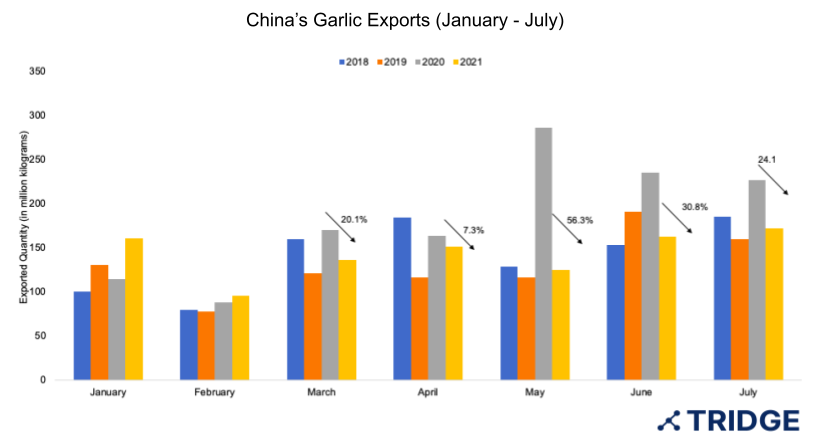China’s Domestic Garlic Prices and Export Volumes on a Path of Recovery

China is the leading exporter of garlic in the world with a share of about 65.6% in global exports. They export garlic to neighboring countries like Indonesia, Vietnam, and Malaysia. According to the Tridge Analysis in August 2021, global demand for garlic had fallen due to which China’s export volumes fell by 20.2% during the first five months of 2021. Apart from demand, external factors like shortage of refrigerated containers, rising sea freight costs, and new waves of lockdown measures impacted the trade opportunities. With limited demand in the domestic market and lower export volumes, the domestic garlic prices in China began to fall.
China’s largest garlic-producing region - Jinxiang county, experienced continuous rain for more than a week at the end of October. There was severe flooding in the growing regions which interfered with the planting process of next season's garlic. The excessive rainfall has also deteriorated the quality of garlic making some of the produce unfit for exports. There has been an increase in the domestic and export price of Chinese garlic due to unfavorable agro-climatic conditions. The price of mixed-grade garlic in Jinxiang was stable at around USD 0.82 per kg while the price of 5.5cm-grade garlic was at around USD 0.94 per kg compared with the average price of USD 0.73 per kg in the same period in 2020, a year-on-year increase of about 28.21%.

Source: Tridge, Price Charts.
On the global trade front, the demand for garlic has been relatively flat in comparison to the previous seasons. During the first eight months of 2021, China exported 104 thousand metric tons of garlic which are 29.13% less than the volume recorded during the same period of 2020. Since March 2021, the monthly volume of garlic exports has been less than the volumes recorded in 2020. However, in the past few months, the production gap between 2020 and 2021 has narrowed. In March 2021, China exported 20.1% less garlic than the 2020 figure which increased to a difference of 56.8% by May 2021. As of July, the gap between 2020 figures and 2021 stands at only 24.1%. In September 2021, China’s export volume was 147,900 tons of fresh or chilled garlic which were only 3.35% less than the September 2020 figures.

Source: ITC TradeMap. HS Code: 070320 Garlic, fresh or chilled.
In terms of production and prices, it is difficult to predict as 2022 has been declared the “La Nina” year - which means that China will experience harsh weather conditions. Garlic being a climate-sensitive crop, needs to be planted carefully to ensure optimum growth and yield. The trade dynamics will continue to be impacted by soaring shipping costs, container shortages, and reduced shipping capacity. The export prices will be determined by the production, garlic stocks, and domestic prices within China.
Sources
- Fresh Plaza. “Heavy rains cause Chinese garlic prices to rise.”
- ITC TradeMap. HS Code: 070320 Garlic, fresh or chilled.
- Tridge Analysis. “Low demand for garlic in global markets hits Chinese exports.”
- Tridge. Price Analysis.





